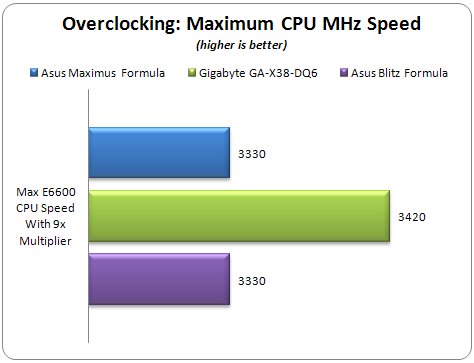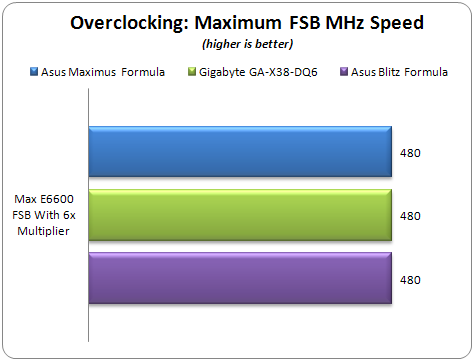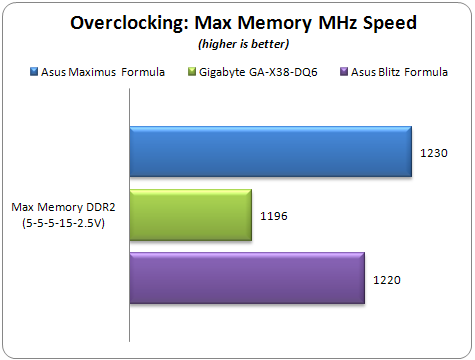Intel X38 Motherboard Roundup
17. Overclocking
Review Pages
2. Asus Maximus Formula
3. The Package
4. BIOS
5. Gigabyte GA-X38-DQ6
6. The Package
7. BIOS
8. Test Configuration
9. Everest Ultimate Edition 2007
10. SiSOFT Sandra
11. PCMARK - 3DMARK
12. Science Mark - PovRay - x264 Benchmark
13. Maxon Cinebench
14. SuperPi
15. SYSmark 2007 - WorldBench
16. Lost Planet: Extreme Condition
17. Overclocking
18. Conclusion
1st Test
In our first test, all motherboards must achieve the highest overclocking speed with all BIOS settings left at Auto. This means each motherboard must calculate the CPU voltage for an absolutely stable system at maximum overclocking speeds. Memory dividers and memory/FSB/MCH voltages are also left at Auto. In other words, it's the easiest overclocking approach. For this test, we use a retail Intel E6600 with it's CPU multiplier locked at x9 and raised the FSB until we get a perfectly stable system (Orthos2004+PovRay running). An additional 8cm rotating fan was used to help with air cooling.

Keeping the CPU multiplier at 9x, the Gigabyte GA-X38-DQ6 produced the highest CPU MHz speed of 3.42 GHz with Auto BIOS settings. Both the Asus motherboards reached 3.330GHz
2nd Test
Apart from the maximum overclocking speed, we have to find the maximum "possible" FSB frequency with our CPU. Again all BIOS settings are left at Auto and the CPU multiplier is dropped down to 6x. Memory timings and dividers are also left at auto. An additional 8cm rotating fan is used to help with cooling.

The best performance comes from Gigabyte GA-X38-DQ6 with 480FSB, while the Asus Maximus Formula also topped 480MHz FSB.
3rd Test
Our final overclocking test is to find out how good each motherboard is when overclocking the memory. In this test, we used one pair of OCZ PC2-8500 SLI dual memory (2x1GB) with the following settings:
- Timings: 5-5-5-15-2T
- Voltage: 2.50V
- FSB:DRAM divider: 1:2
- Additional 8cm rotating fan
- All other BIOS settings left Auto
By raising the FSB, we monitored the stability until we get a top roof. The highest memory speed we got with the Asus Maximus Formula was 1230MHz. The system was totally stable. On the other hand, Gigabyte GA-X38-DQ6 gave lower performance with 1196MHz. Note that the Asus Maximus Formula was able to boot into Windows up to 1260MHz, while the Gigabyte GA-X38-DQ6 reached an astonishing 1288MHz.

- Overclocking stability
Both the Gigabyte GA-X38-DQ6 and Asus Maximus Formula were very impressive in their overclocking stability. Most of the time, the system was able to POST from a failure and prompted either to correct the settings, or simply have the system automatically return to default settings. We don't have any complaints from any of the motherboards in that particular area.
Review Pages
2. Asus Maximus Formula
3. The Package
4. BIOS
5. Gigabyte GA-X38-DQ6
6. The Package
7. BIOS
8. Test Configuration
9. Everest Ultimate Edition 2007
10. SiSOFT Sandra
11. PCMARK - 3DMARK
12. Science Mark - PovRay - x264 Benchmark
13. Maxon Cinebench
14. SuperPi
15. SYSmark 2007 - WorldBench
16. Lost Planet: Extreme Condition
17. Overclocking
18. Conclusion





















